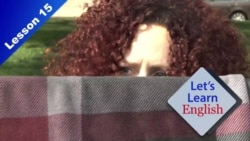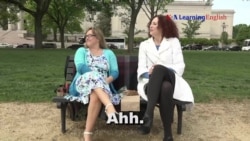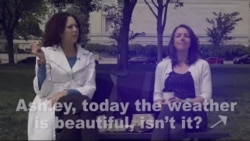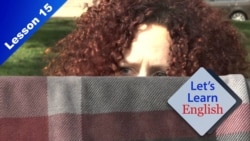Summary (Ringkasan)
Anna and her friends are eating lunch outside on a beautiful day in Washington, DC. They are people-watching. They like seeing the many different people walking by.
Anna dan teman-temannya sedang makan siang di hari yang cerah di Washington, DC. Mereka melihat-lihat kerumunan orang. Mereka suka melihat banyak orang yang sedang berjalan.
Speaking (Berbicara)
In this video, you can learn to say the new words. Learn about the sounds English speakers make to show they are happy. You can also download the Activity Sheet and practice talking about how people look with a friend.
Di video ini, coba mengucapkan kata-kata baru. Dan juga, belajar dari suara yang dikeluarkan dalam berbicara bahasa Inggris untuk menunjukkan perasaan bahagia. Anda juga dapat mengunduh Lembar Kerja dan berlatih berbicara tentang bagaimana rupa seseorang dengan teman.
Pronunciation (Pengucapan)
In this video, you learn about how to make tag questions. These are the short questions at the end of a sentences, as you hear in the video, "It's a beautiful day, isn't it?"
Di video ini, Anda belajar mengenai membuat pertanyaan di akhir pernyataan. Ini adalah beberapa pertanyaan di akhir kalimat, saat Anda mendengar, "It's a beautiful day, isn't it?"
Conversation (Percakapan)
Writing (Menulis)
What do you look like? What does your friend look like? Write to us by email or in the Comments section. Click on the image below to download the Activity Sheet and practice with a friend.
Learning Strategy (Strategi Belajar)
Learning Strategies are the thoughts and actions that help make learning easier or more effective.
The learning strategy for this lesson is Access Information Sources. In our digital world there are many free sources of information to help you learn English. And remember that other people can also help. Here is an example.
João is visiting Miami. He wants to take a tour of the National Park in the Everglades (or marismas in Portuguese). He finds the word "Everglades" in his pocket paperback Portuguese - English dictionary, but doesn't know how to pronounce it. He opens a translation web page on his phone, writes "Everglades" and pushes the button to translate. Soon a symbol appears under the word. João clicks on the symbol to hear the sound of the word, "Everglades." He goes to the hotel tour desk and asks, "Do you have a tour of the Everglades?" The clerk understands him and begins to show him the tour information. João asks the clerk, "Will you please say the word slowly for me? I want to check my pronunciation." The clerk smiles and pronounces the word and João says it again. Now João is sure he can say it correctly.
How do you access information sources when learning English? Write to us in the Comments section or send us an email. Teachers, see the Lesson Plan for more details on teaching this strategy.
Strategi belajar adalah gagasan dan tindakan yang akan mempermudah pembelajaran dan membuatnya lebih efektif.
Strategi belajar kali ini adalah Access Information Sources. Dalam dunia digital, ada banyak sumber informasi yang bisa membantu Anda belajar bahasa Inggris. Jangan lupa orang lain juga bisa membantu. Ini contohnya.
João berkunjung ke Miami. Ia ingin tur di National Park in the Everglades (atau marismas dalam bahasa Inggris). Ia menemukan kata "Everglades" di kamus Portuguese - English, tapi tidak tahu bagaimana mengucapkannya. Ia membuka situs terjemahan di hp-nya, dan menulis "Everglades". Lalu ada simbol yang muncul di bawah kata-katanya. João mengklik simbol itu untuk mendengar pengucapannya, "Everglades." Ia mendatangi meja tur dan bertanya, "Do you have a tour of the Everglades?" Petugas bisa mengerti apa yang dikatakannya dan memberikan informasi. João bertanya kepada petugas, "Will you please say the word slowly for me? I want to check my pronunciation." Petugas tersenyum dan mengucapkan kata tersebut dan João mengulanginya. Sekarang João yakin ia bisa mengucapkan kata tersebut dengan benar.
Bagaimana Anda belajar bahasa Inggris? Tulis di kolom komentar atau email kami. Teachers, see the Lesson Plan for more details on teaching this strategy.
Quiz (Kuis)
Test your understanding by taking this listening quiz. Play the video, then choose the best answer.
Tes pemahamanmu dengan mengikuti kuis mendengarkan ini. Mainkan videonya, lalu pilih jawaban yang benar.
______________________________________________________________
New Words
______________________________________________________________
Free Materials (Kata-kata Baru)
Download the VOA Learning English Word Book for a dictionary of the words we use on this website.
Each Let's Learn English lesson has an Activity Sheet for extra practice on your own or in the classroom. In this lesson, you can use it to practice describing people.
Unduh VOA Learning English Word Book sebagai kamus kata-kata yang digunakan di situs ini.
Masing-masing pelajaran dalam Let's Learn English, ada Lembar Kerja agar Anda bisa belajar sendiri atau di kelas. Di pelajaran kali ini, Anda bisa menggunakannya untuk berlatih mendeskripsikan orang.
For Teachers
See the Lesson Plan for this lesson for ideas and more teaching resources. Send us an email if you have comments on this course or questions.
Grammar focus: Descriptive adjectives; Tag questions
Topics: Describing Differences and Similarities; Watching People
Learning Strategy: Access Information Sources
Speaking & Pronunciation Focus: Non-Verbal Expressions of Happiness; Rising and Falling Intonation in Tag Questions
______________________________________________________________
Now it's your turn. Send us an email or write to us in the Comments section below or on our Facebook page to let us know what you think of this lesson.
















